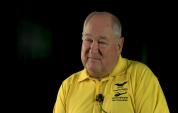5:28 | The Mekong Delta was hot and it smelled peculiar, especially where the locals were making their fish sauce. Marshall Eubanks was a Huey pilot who arrived there late in the war. There were a lot of river tributaries and canals and the villages were often built on poles.
Keywords : Marshall Eubanks helicopter (chopper) pilot Vietnam Fort Rucker Cam Ranh Bay Mekong Delta Mekong River Vinh Long IV Corps

Marshall Eubanks was determined to go to Vietnam. He felt personally called to duty after going to college during the turbulent sixties. Also, his father, who was a career military man, had died there. He went to flight school in his senior year of ROTC and, after graduation, became a helicopter pilot.
By the end of 1971, all US combat troops were gone from the Mekong Delta area, but helicopter pilot Marshall Eubanks was kept busy transporting ARVN troops. The procedure was to hover just above the tall grass and the men would jump out. There was no way to know how far down the ground actually was, so sometimes thy didn't want to go.
The 114th Assault Helicopter Company was based at a small airfield in Vinh Long. Huey pilot Marshall Eubanks was sometimes officer of the guard for night time security, not a lot of fun. Neither was it fun to thoroughly clean all the aircraft when the unit had to stand down and prepare for return to the States. He didn't have enough time in country to leave, so he went to another outfit.
The monsoon weather was awful but Huey Pilot Marshall Eubanks flew right through it. He had to fly low enough to watch the ground beneath him until he got through the storm. That was scary enough. Then there were night assaults that were lit up by spotlights, which made you a sitting duck.
Flying out of Can Tho, helicopter pilot Marshall Eubanks supported the American advisory teams in the Mekong Delta. Transport, supply Medevac, anything they needed. He also made runs to Cambodia to support the American embassy and, on one of these, he was treated to a feast at Angkor Wat.
Sometimes the advisors rubbed you the wrong way, but Marshall Eubanks recognized the bravery of the men who lived in the bush with ARVN units. The tiny outposts had to be supported constantly and he had a special maneuver for bringing his Huey down quick in a tight spiral to avoid ground fire.
Marshall Eubanks was a helicopter pilot in Vietnam when Jane Fonda was photographed at a North Vietnamese anti-aircraft battery. He and his comrades did not appreciate it then and they still do not appreciate it.
When you sat your chopper down in a village, the kids would gather to look at the aircraft and maybe get a handout. Huey pilot Marshall Eubanks noticed that the Vietnamese children always looked out for each other and the older ones would shepherd the younger ones. They seemed very independent and resilient.
Marshall Eubanks describes the immense power of the B-52 strikes that he witnessed. There couldn't have been much effect on the enemy, however, because the strikes were announced in advance to avoid civilian casualties. Vietnamese civilians could also easily become casualties if they ventured into a designated free fire zone.
It was a typical mission. Huey pilot Marshall Eubanks made three trips to resupply an ARVN outpost and on the third one he took a lot of ground fire. He didn't think much of it but, later, after he was home from his tour, he got word that he was requested at an award ceremony.
It was very late in the war but lives were still being lost. Helicopter pilot Marshall Eubanks remembers the deadly crash of a Chinook which sunk down into the Mekong mud. He nearly lost his own life on his last flight in Vietnam when his Huey developed engine trouble.
They were long days, those last few in country as Marshall Eubanks was waiting to leave Vietnam. He was ready to go home after twelve long months. When he got back to the States and his next assignment, he was surprised when he was told not to wear his uniform off base.
What should people remember about the Vietnam war? Marshall Eubanks thinks it's important you know that most of those who served there volunteered and that they stepped up for the same reasons volunteers do it today.
Marshall Eubanks had two years left to serve when he returned from Vietnam. He stuck around for ten, then he decided to keep going. Instead of flying helicopters, he worked on high level research and simulations, among other things.